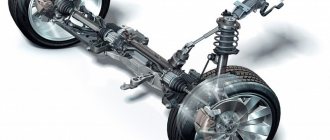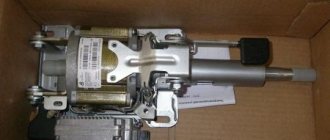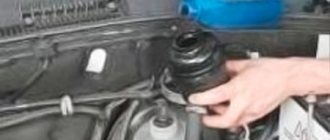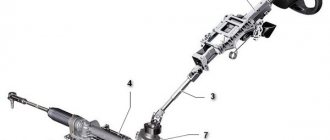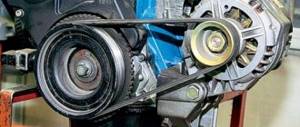Power steering (power steering) found in almost any modern car. The power steering function is to facilitate steering turns by pumping oil at high pressure. Heavy-duty vehicles are especially dependent on power steering; without it, turning the huge wheels would be impossible.
Next we will talk about changing the oil in the power steering on a Lada Priora yourself. Experienced car owners know that this should be done at least once every 4-5 years (every 80 thousand kilometers). We have already considered replacing the VAZ 2115 power steering oil. There are no particular differences from a similar procedure on the Lada Priora.
Algorithm for replacing power steering fluid Lada Priora
- Raise the front end with jacks (this will make it easier to drain the old oil)
- Use a syringe with a hose of the required diameter (you can use a washer hose) to pump out the oil from the tank.
power steering fluid. This post is for smart people
garage_rudimmcompany Buenos noches amigos! in short, the conditions of the problem are power steering, there is a slurry recommended by the car manufacturer with the parameters WSS-M2C204-A2 (whatever) about the color they write that green there is a store with an analogue on which it says WSS-M2C204-A (like synthetics, it seems) desperate googling did not help , since everything is packed with shops and forums, I even came across insider information from the dealer program, which only puzzled me even more
2) The latest 2010 revision of the ATF specification for power steering WSA-M2C-195-A states that it will no longer be developed and is covered by Mercon LV C-ML5, aka WSS-M2C-938-A and WSS-M2C204-A2 (green ). In particular, some Fords are already filled with green power steering fluid (manufactured by Pentosin) Information from a foreign site, unfortunately the site was redone and from a technical one it turned into a “business card” FORD WSA M2C195 A:2010 Engineering Material Specification - Fluid, Power Steering General Product Information Status : Superseded Superseded By: FORD WSS M2C204 A2:2003 FORD WSS M2C938 A:2007 That is, slurry number 195 is replaced by slurry 204 A2, but something suggests that there is a risk that replacement in both directions may not work. an attempt to get into Pentosin is also unsuccessful for the Pentosin CHF115 e-liquid we have an exact indication of 204-A for the Pentosin CHF202 e-liquid we do not have an exact indication for a replacement So, question 1. is it possible to fill in 204-A instead of 204-A2 Supergame, how does 204-A differ from 204 -A2 if Green ATF WSS-M2C204-A DP-PS 1384110->1781003 (aka Pentosin CHF11S) for power steering (electric power steering), although it has better low-temperature and anti-wear properties, it is not suitable for power steering due to lower viscosity. Pentosin CHF202 - a cheaper version of CHF11S, made to order from VAG (PAO was changed to hydrocracking) general educational picture to increase erudition blade-type power steering device
Replacing power steering fluid in Lada Priora - step-by-step instructions
1. First of all, you need to jack up the front end, this will simplify the task when you need to expel old oil from the system. To do this, use two jacks.
2. To pump out the oil from the tank, take a syringe and put a hose of a suitable diameter on it (suitable from a washer or medical “system”).
3. Then cover the belts with something (cellophane, a rag) so that oil does not get on them, rubber does not like this.
4. Start pumping the oil into the prepared container.
5. When the oil is pumped out, ask an assistant to turn the steering wheel as far as possible to the left/right. With these movements, oil will appear in the tank again, your task is to immediately pump it out.
6. After this, disconnect the “return” hose and lower its end into some bottle, and turn the steering wheel again, the system will again expel the old oil.
7. After the oil has been completely drained, reconnect the hose.
8. Fill the power steering system with new oil, up to the top.
- When the oil is poured, ask a friend to turn the steering wheel, while you continue to add oil as it decreases into the system.
- After the oil has stopped decreasing, start the engine for 10-15 seconds. During operation, the oil will also decrease - add again.
- Turn off the engine, turn the steering wheel again 5-7 times in each direction until it stops, make sure that there are no air bubbles in the tank.
- Add oil to the level if necessary.
- Check the operation by starting the engine and trying to turn the steering wheel. There should be no noise or difficulty during rotation, the steering wheel should be soft and rotate without problems.
Video “Testing the operation of MAZ power steering”
The vdm melitopol channel talks about diagnosing a power steering system with a pump using a special stand.
Most modern cars are equipped with power steering. This device is necessary so that when maneuvering at low speeds, turning the steering wheel is easy, and when driving at high speeds, the required force for turning is more noticeable. It happens that the power steering fails. What to do in this case? There are two options: contact a service center or repair the power steering yourself. If you have experience in car maintenance and have a little theoretical knowledge, then you can handle most power steering faults yourself.
Preparing for power steering repair.
Many motorists probably know the technology for repairing power steering and installing it back on the car. But as far as the preparatory work for this process is concerned, many questions always remain. Let's look at how to prepare the power steering for repair. So, to prepare the device for repair, you need to perform the following steps:
1.
The hydraulic booster must be thoroughly cleaned of dirt, since when the hoses are disconnected, this dirt can get into the cavities of the unit.
2.
You need to pump out as much liquid as possible from the pump reservoir.
3.
Unscrew the clutch screws from the steering shaft located on the bottom of the car. It is important to remember the initial position of the coupling relative to the power steering shaft or mark its position.
4.
Using a pry bar, move the elastic coupling from the splines.
5.
Using a puller, disconnect the steering rods from the bipod.
6.
Raise the car using a jack and remove the front left wheel.
7.
From the wheel arch side, loosen the three bolts that secure the power steering to the side member. Two of these bolts need to be removed. For this operation it is necessary to use a socket wrench of the appropriate diameter (usually suitable for “15”).
8.
Place a container for liquid under the hose fittings. After this, disconnect them one by one, waiting for the liquid to drain.
9.
Ensure that the fittings and hoses are sealed, for which even an ordinary rag will do.
10.
Unscrew the remaining bolt while holding the power steering with one hand from the bottom of the car. Here you need to be very careful and careful so that the gearbox does not fall on your foot.
11.
Wash the gearbox thoroughly before disassembling.
Basic faults of the power steering.
– a fairly reliable mechanism that does not require complex maintenance during operation. And even if it fails, you can continue moving. But to turn the steering wheel you will have to put in more effort.
There are two main types of faults
hydraulic booster:
1. Hydraulic
(related to the working fluid; this could be, for example, its untimely replacement, operation at low temperatures).
2. Mechanical
(related to malfunctions of individual power steering systems, for example, leakage, pump failure).
Let's consider the main malfunctions of the power steering and methods for eliminating them:
1. Reverse shocks of the steering wheel.
Reasons: poor tension or wear of the pump drive belt. Remedy: replace the belt, tighten or adjust the position of the belt.
2. More effort is required to turn the steering wheel.
Reasons: the pump belt is poorly tensioned or worn, the fluid level has dropped below the required value, the engine makes few revolutions at idle, the tank filter is dirty, the pump pressure is too low, air has entered the device. Elimination methods are to tighten or replace the drive belt, add fluid to the device, adjust engine idle speed, clean or replace the filter, repair or replace the pump, adjust the tightness of all seals and get rid of air trapped in the device.
3. To rotate the steering wheel in the middle position, significant force is required.
Reasons: the pump is faulty, there is a mechanical fault in the steering system. Elimination methods - check or replace the pump, diagnose the steering system.
4. To rotate the steering wheel in one direction, significant force is required.
Causes: the pump is faulty. Remedy: check and repair the pump, replace the pump seals.
5. It takes a lot of effort to turn the wheel quickly.
Reasons: the drive belt is loose, low engine speed at idle, air has entered the device, the pump is faulty, there is a mechanical fault. Elimination methods are to replace or adjust the drive belt, adjust engine idle speed, check for leaks and remove air from the system, repair or replace the pump, and diagnose the entire steering system.
6. Steering is unclear.
Reasons: the fluid level in the reservoir is too low or it is leaking, air has entered the hydraulic system, parts of the steering mechanism have been demolished, the geometry of the steering drive is broken, problems with tires. Elimination methods - add fluid to the hydraulic system and eliminate the leak, check for leaks and remove air trapped in the system, diagnose the steering systems and eliminate detected faults, replace the tires with new ones.
7. The steering gear is noisy during operation.
Reasons: the fluid level in the tank has decreased, fluid has been discharged through the safety valve (a whistling sound is heard in the extreme position of the steering wheel). Elimination methods - add fluid to the tank, make sure there are no leaks, check the pump, replace the safety valve.
8. Strong vibrations are felt when the system is operating.
Reasons: air has entered the hydraulic system, the tires are damaged or are in poor condition. Elimination methods are to remove air from the hydraulic system and determine the cause of its entry, inspect and repair the tires or completely replace them.
1. It is necessary to periodically replace the working fluid of the device, since dirty fluid causes rapid wear of the mechanism elements.
2. It is necessary to constantly monitor the fluid level in the system and replenish it in a timely manner. If the level drops below the critical point, then all parts begin to wear out.
3. You should only use fluid specifically designed for a specific car.
Power steering repair technology.
The design of the power steering varies from car to car, so each car has its own technology for repairing this element. But the general aspects that will help repair the power steering remain the same for all cars. The main rule that helps you repair a hydraulic booster with your own hands as efficiently as possible is that you need to be very careful and careful not to lose the components of the device.
Power steering repair consists of the following sequence of actions:
1. The hydraulic booster is removed from the car.
2. The hydraulic booster is inspected and the cause of the breakdown is determined.
3. The cause of the breakdown is eliminated.
4. The device is re-installed on the car.
Before repairing any device, it must be properly disassembled. Disassembling the power steering consists of the following steps:
1.
For disassembly you will need a hex wrench (usually “6” is suitable) and a container for draining ATP fluid.
2.
Remove the plugs from the fitting, and, lifting the hydraulic booster above the container, rotate the bipod until all the liquid has drained.
3.
Remove the bipod shaft and unscrew the four bolts. These bolts are “set” on a special mastic, so they are a bit difficult to unscrew.
4.
Unscrew the locknut of the adjusting screw and screw it into the gearbox. This will push out the bipod and the shaft with the gearbox cover. If there is no play in the device and there is no need to change the cuff, then the bipod does not need to be removed.
5.
Unscrew the check valve plug.
6.
Remove the spring and shake the valve.
7.
Unscrew the cover bolts and, turning the shaft, wait until it pushes the cover out of the housing. Remember, you cannot unscrew the shaft from the ball nut.
8.
Pry up the resulting gap and pull out the shaft with the cover and piston from the gearbox.
9.
Remove the ball nut by unscrewing the shaft and keeping the balls.
10.
Loosen the locknut and unscrew the bearing.
11.
Remove the nut and bearings from the piston housing. Disassemble the nut by bending the locking bolts. Unscrew the bolts, remove the bracket and two parts of the channel from the ball guide.
12.
After this, you can begin to find and eliminate the causes of the breakdown.
13.
When reassembling the power steering, do not forget to lubricate all parts with ATP fluid.
When disassembling, be sure to remember the entire process so that later you can correctly reassemble the device in the reverse order. If this is your first time carrying out such an operation, use the detailed drawings of your power steering and refer to the vehicle's operating manual. A good option is to lay out all the details of the device one by one and sign them. This way you definitely won’t forget or lose anything.
All work on repairing the hydraulic booster should be carried out only in clean rooms and at a large table on which all the parts will fit. For many motorists, self-repair of the power steering, as well as other elements of the car, becomes a favorite pastime, and they spend a lot of time on it, getting a lot of pleasure from the results of the work.
Which power steering repair operations can you do yourself, and which are better to entrust to a service center?
If a motorist has impressive experience in operating a vehicle and experience in servicing it, then he can carry out almost all power steering repair operations on his own. If the driver is a beginner and does not understand the structure of the car, then it is better to transfer any operations on maintenance and repair of the power steering to a service center. But most car owners, although they do not fully know how the car works, have little experience and skills in servicing the vehicle. Such owners can still carry out part of the power steering repair operation with their own hands. Power steering repair operations that you can do yourself:
1.
Periodic inspection of the condition of the hydraulic system for timely detection of its malfunctions.
2.
Replenishment or replacement of working fluid in the device.
3.
Cleaning power steering filters or replacing them.
4.
Adjusting or replacing the drive belt of the device.
5.
Replacing power steering hoses.
6.
Eliminate air trapped in the hydraulic system.
7.
Replacing pump seals.
8.
Adjusting engine idle speed.
9.
Replacement of the safety valve.
10.
Replacing pump seals.
Power steering repair operations that are best transferred to specialists from a service center or service station:
1. Complete repair of the power steering pump. This is the main element in all hydraulic boosters and mistakes in its repair are unacceptable.
2. Diagnosis and troubleshooting of all steering systems.
3. A severe leak has formed in the system and it is impossible to determine its causes.
In modern cars, manufacturers install additional systems to ensure better vehicle controllability. For this purpose, the car is equipped with power steering. With its help, at low speed the steering wheel rotates much more easily.
However, due to intensive use, the unit may be subject to wear. In such cases, you will need to either contact a service center or repair the power steering pump yourself. If the broken parts turn out to be repairable, then the driver will receive a working unit after restoration and at the same time save money.
Before removing and disassembling, it is necessary to familiarize yourself with the design of the pump, because if it is assembled incorrectly, after the repair is completed, you can also end up with a non-functional unit. Dirt and debris should not get inside the unit; to do this, it is washed from the outside. To pump out excess fluid from the system, use a large syringe.
Dismantling begins with unscrewing the coupling screws from the steering shaft. It is necessary to remember or sketch the location of the coupling relative to the shaft. It can be moved if you use a pry bar and slide it along the slots.
We disconnect the steering rods from the bipod using a puller. Next, jack up the “driver’s” front wheel and remove it to provide access to the unit. Do-it-yourself power steering repairs must be carried out with safety in mind. To do this, the car is blocked using anti-rollbacks.
We loosen the fixed hydraulic booster by unscrewing the bolts securing it to the side member. Most often, you will need a 15mm hex head. A couple of bolts can be removed completely, and using the remaining fasteners we disconnect from the hoses. We install a wide container under the assembly to collect the waste, and after disconnecting the hoses and fittings, wait for the excess liquid to drain off.
Having closed the cavity with a clean rag, unscrew the remaining bolt. This must be done carefully so that the gearbox does not fall. Now you can flush the node before resuscitating it.
Stories from our readers
“Fucking basin. "
Hi all! My name is Mikhail, now I’ll tell you a story about how I managed to exchange my two-wheeler for a 2010 Camry. It all started with the fact that I began to be wildly irritated by the breakdowns of the two-wheeler, it seemed like nothing serious was broken, but damn it, there were so many little things that really started to irritate me. This is where the idea arose that it was time to change the car to a foreign car. The choice fell on the melting Camry of the tenth years.
Yes, I had matured morally, but financially I just couldn’t handle it. I’ll say right away that I am against loans and taking a car, especially not a new one, on credit is unreasonable. My salary is 24k a month, so collecting 600-700 thousand is almost impossible for me. I started looking for different ways to make money on the Internet. You can’t imagine how many scams there are, what I haven’t tried: sports betting, network marketing, and even the volcano casino, where I successfully lost about 10 thousand ((The only direction in which it seemed to me that I could make money was currency trading on the stock exchange, they call it Forex. But when I started delving into it, I realized that it was very difficult for me. I continued to dig further and came across binary options. The essence is the same as in Forex, but it’s much easier to understand. I started reading forums, studying trading strategies. I tried it on a demo account, then opened a real account. To be honest, I didn’t manage to start earning money right away, until I understood all the mechanics of options, I lost about 3,000 rubles, but as it turned out, it was a precious experience. Now I earn 5-7 thousand rubles a day. I managed to get the car buy after half a year, but in my opinion this is a good result, and it’s not about the car, my life has changed, I naturally quit my job, I have more free time for myself and my family. You’ll laugh, but I work directly on the phone)) If If you want to change your life like me, then here’s what I advise you to do right now: 1. Register on the site 2. Practice on a Demo account (it’s free). 3. As soon as you get something on the Demo account, top up your REAL ACCOUNT and go to REAL MONEY! I also advise you to download the application to your phone, it’s much more convenient to work from your phone. Download here.
Common faults
Most experienced drivers know that during operation, steering hydraulics require virtually no attention from the car owner. Therefore, before repairing the power steering pump, you need to know that it is customary to distinguish two types of faults:
- mechanical wear or damage;
- hydraulic problems.
In the first case, the culprits are large gaps that violate the tightness, pump failure, or wear out of individual elements. In the second case, attention switches to the properties of the liquid, loss of its performance characteristics, and insufficient level in the system.
When operating a vehicle with a damaged or inoperative power steering, various manifestations of this problem are possible. Let's look at the most popular of them and some troubleshooting methods.
When, when turning the steering wheel to one side, the driver is forced to exert more force than usual, this is the cause of a pump malfunction. To fix it, you will need to replace the seals or repair the pump itself.
The appearance of reverse shocks indicates a weak tension or wear of the belt on the drive.
The defect can be eliminated by replacing the belt or increasing the tension.
If the steering wheel turns tightly in both directions, this is often a consequence of a low fluid level or insufficient idle speed, or low pump pressure, or the presence of air in the system. It is also possible that the belt drive may become loose. In some cases, it is necessary to clean the tank filter.
When the steering wheel is stiff in the middle position, most likely the reason lies in a mechanical fault in the steering. You also need to check the functionality of the pump.
A characteristic noise that appears from the steering column may indicate a low fluid level in the system. It can escape through the safety valve. The poor performance of the latter is noticeable by an audible whistle from the engine compartment when the steering wheel is in the extreme position. A non-working valve can be replaced separately from the pump or together with it.
When obvious vibration is felt while driving, the reason lies in an air lock that has appeared. You need to get rid of it, and also eliminate the cause of air in the hydraulics.
Power steering reservoir with filter
The standard power steering reservoir on Lada cars is non-separable (manufacturer: ZF). There is a filter inside it, which is a fine mesh. If you think that such protection is not enough, install a power steering reservoir from Volga (GAZ 3110), catalog number: 3105-3407178. There are two types to choose from:
- plastic (non-separable) power steering reservoir with built-in filter (price 150 rubles);
- metal power steering tank with a replaceable filter (tank price is about 500 rubles, replaceable filter 40 rubles).
No modifications are required to install it, because... The tank from Volga and ZF are almost the same in size and have two pipes (inlet and outlet) with the same diameters. Replacement using the example of a VAZ 2110 car, where the power steering is like on a Priora.
Let us remind you that AvtoVAZ installs electric power steering on other Lada cars (Granta, Kalina, etc.). If malfunctions occur, you can diagnose the EUR yourself.
Power steering is an important part that helps you easily drive your car in the most emergency situations. Its use allows you not only to get more pleasure from driving, but also significantly increases overall safety on the roads. This is all due to the fact that with the help of power steering it is much easier for the driver to manage complex maneuvers.
However, over time this part becomes unusable. Particularly high wear is observed with dangerous driving styles. Sharp turns significantly reduce the service life of the power steering, and it requires repair.
Interchangeability and classification of oils
Typically, oils are divided into several types depending on color. How often to change the oil has already been described. The classification by color is not entirely correct. And don’t think that you can mix different brands of oils, even if they have exactly the same color. The composition and viscosity can always be different.
Power steering oils vary and have different features depending on the color.
There are some features associated with the color of the oil that are worth considering in more detail.
- Green color. This family is mainly used in VAG, Citroen, and Peugeot cars. The main thing is to never mix mineral water with synthetics if they have this color. Automatic transmission oil is never suitable.
- Mercedes cars use a yellow grade of oil.
- Dexrons are red. Only for automatic transmissions.
Synthetic oil can be added to power steering, but not in every case. To get the desired result, you need to understand whether the rubber parts have a special composition. But there are quite a few such options available.
Lada 2112 #music box (: › Logbook › installing power steering in a 16v basin (:
the moment has come when you have a little time to talk about your pelvis) for more than half a year, there are just a lot of improvements.
Today I’ll try to tell you in detail about installing power steering in my engine)
True, I staged it last year, but I’ll try to tell as many of the nuances as possible.
there is nothing complicated in this procedure) although I will say right away that I carried out the entire procedure myself without anyone’s help.
but sometimes there is simply a catastrophic lack of an assistant.
so keep that in mind.
1.
Rack
2.
Cardanic steering rack with power steering (with a regular one it will not work) ps cardanic with power steering racks with two crosses (more details are shown in the photos below)
3.
“Interior” boot (also needed with power steering)
4.
Damper hose for supply from the pump to the rail (consists of 2 parts)
5.
Return hose from the tank to the rail
6.
Power steering pump
7.
Hose from the tank to the pump
8.
Tank
9.
Tank mounting bracket
10.
Pump mounting bracket
11.
Generator mounting bracket
12.
Mounting bracket attachment roller
13.
Attachment roller
14.
Attachment Belt
15.
1 liter of new power steering fluid (Dextron 2, 3, etc.)
I don’t think there’s any need to write about the fact that you also need clamps to crimp the hoses into their seats... well, a couple of bolts will also be needed, because... We also have an additional unit that must be screwed to the block with something)))
When we have the entire set in hand, we can begin to remove everything that is no longer necessary for us. You can start with anything, as you wish. I will tell you my sequence, how it happened for me.
Be sure to REMOVE THE TERMINALS FROM THE BATTERY!
Well, here we go))
— We take off the belt and generator. — Remove the timing cover. — Unscrew the steering rods on the rack. — We unscrew the cardan in the cabin from the rack. — Unscrew the rack fastening and remove the rack. — Remove the interior boot (the boot through which the rail is inserted into the interior). ps the boot of the rack without power steering is purely metal, but with power steering it has a rubber band) — We remove the entire cardan assembly.
...pictures and a lot of text to be continued)))
From the analysis you can tell everything.
Next we proceed to the installation.
—
We install a new interior boot with power steering kit (I already tried to explain from above what kind of boot it is, I think you’ll understand from the photo)
-
We install a new driveshaft.
—
We put and screw the rail into its new, rightful place.
ps
it is advisable to immediately replace the rubber bands in the fastening places with new ones... they cost pennies, and then so that you don’t have to change them if the rack “plays” in the old ones.
—
We screw the cardan into the cabin.
ps
it is advisable to put it on when inserting the rack into the “interior boot” and do this with an assistant.
One puts the rack in place, while the other puts the cardan on the rack slots. ps2.
If it’s not very clear, open the Murzilka and look there about installing the slats.
—
We screw the steering rods to the racks.
ps
by the way, I forgot to say right away, the tie rods are still the old ones)
—
We install new brackets and attach the power steering pump and generator.
ps
the pump is placed in the former place of the generator, and “Gennady” is placed on top.
—
Connect the supply hose from the power steering to the rack.
—
We attach the power steering reservoir.
—
Connect the supply hose from the tank to the pump.
—
We are laying the return line from the rail to the tank.
—
Attach the mounting roller bracket.
—
Cuts a round hole in the timing cover for a new bracket.
ps
from the factory there is this “round piece” in the timing cover, it must either be broken off (which should not be done) or drilled and aligned beautifully.
—
Screw the timing cover into place.
—
Unscrew the right engine mount.
—
Using a jack from below, we lift the engine and place the belt under the cushion.
—
Screw the pillow back.
—
We put on the roller.
—
We put the belt on the crankshaft, roller, generator, power steering pump
—
We tighten it all and clamp it.
The most “difficult)))” is over.
All that remains is to fill the system with liquid and enjoy life))))
—
Fill the tank full, just don’t spoil it)
-
Connect the battery terminals. Now your assistant sits in the basin to start the car, and at this time you stand with a can of power steering fluid in your hands and as soon as the car starts, the fluid will drain. Your task is to not let it completely leave the tank... In general, top up and that’s it, so that it doesn’t snatch air) And the assistant must start the car and turn the steering wheel from lock to lock (from one end to the other)
